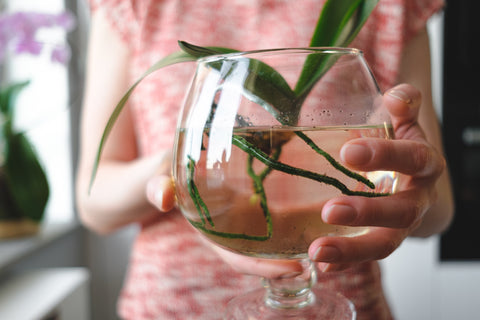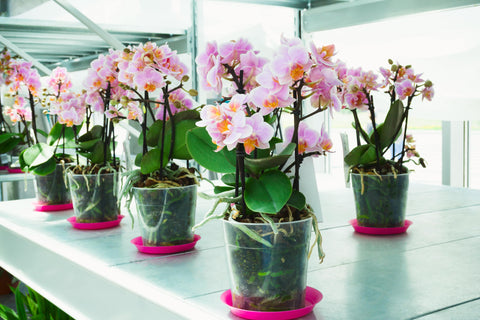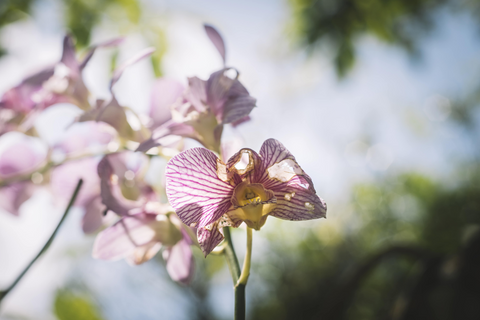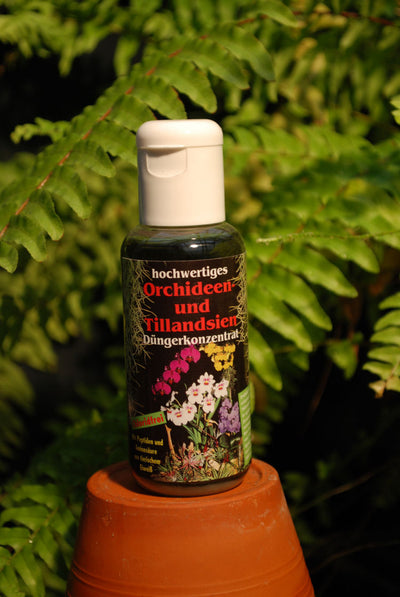How to care for orchids properly
Caring for an orchid is nothing to shy away from. Although they have a reputation for being difficult to care for, they're actually not that difficult once you understand the basics.
In this blog post, we'll share some simple tips and tricks on how to properly care for your orchid so that it thrives in its new home! Make sure you avoid common mistakes and give your orchid the best possible treatment.
Why orchid care is so important
Orchids are not only beautiful and popular houseplants , but they are also a little demanding to care for. Why is proper care so important? It's simple: a neglected orchid quickly leads to a miserable existence or even the death of the plant. But with a little effort and attention, you can enjoy your orchid for many years.
To best care for your orchid, you should familiarize yourself with its specific needs, such as providing the right amount of light and water , checking for pests and diseases , and repotting regularly . By making sure your orchid receives the best care possible, it will reward you with stunning blooms and healthy foliage.
But: Even if proper care is the best way to prevent diseases, your orchid can still be attacked by pests. Then you should look for the cause and nurse your plant back to health.
The right location for orchids
Orchids are sensitive creatures and need a lot of light. Direct sunlight is bad for them from April to August, so they should be placed on the windowsill in a west or east-facing window and additionally protected from direct sunlight in the warm months to prevent the leaves from getting sunburnt.
High humidity conditions are also ideal. Plants in places with low humidity should be sprayed regularly with low-lime water to encourage growth. Make sure that the water does not remain in the leaf axils to avoid the formation of rot.
Watering orchids
Water requirements vary depending on the type of orchid. Orchids with bulbs or leathery leaves can store water and can tolerate being left dry for a few days. These plants respond well to heavy watering once a week . Other orchids, such as the lady's slipper , require consistent moisture and should be watered with fresh water once or twice a week .

To ensure that they grow healthily and luxuriantly, it is important to avoid waterlogging and to water them regularly. The guideline is once a week, unless the orchid has flowers or buds or is growing in spring, when it needs a little more water. In winter, on the other hand, watering should be more sparing. Make sure that the root ball is dry before watering the orchid.
When, how and with what you should water orchids
When it comes to the right water, rainwater at room temperature is best because it has a low salt content and pH value and is very soft. Alternatively, boiled tap water can also be used.
When and how should we best water our plants? Not only the type of watering is important, but also the right time. Plants that are watered in the morning have time to dry and thus avoid rot. There are various watering options for orchids, such as a watering can, a shower head or even a water bath. Just try out these options and see how your plant reacts.
Fertilizing orchids
You shouldn't just start fertilizing your orchids. We've summarised the most important things for you below.
How often should you fertilize orchids?
Houseplants need regular fertilizer because their nutrient supply is limited. A natural supply of nutrients is difficult because there are only low concentrations in water and soil. However, orchids are light feeders and only need minimal amounts of nutrients. Fertilizing too generously can damage sensitive roots.
To ensure your plants are optimally fed, you should mix liquid fertilizer into the water every few weeks. But be careful: the dosage recommended by the manufacturer should never be exceeded! Too much fertilizer can lead to white crystals on the roots and substrate and, in the worst case, even burn the aerial roots. But don't worry - this can be easily avoided by using slightly less fertilizer.
When should you fertilize the plants?
Orchids need nutrients for growth and flowering. Especially in spring, you should fertilize them every two weeks to encourage growth. In winter and after repotting , however, they need fewer nutrients and should be fertilized less often or not at all.
What should be used for fertilizer?
In order to provide them with the best possible care, it is recommended to use special orchid fertilizer . This has an optimal composition that perfectly meets the nutritional needs of orchids, is low in salt and is compatible with the flora. However, the orchid substrate should also be taken into account when choosing the fertilizer, as coarse and not very moist substrate makes it difficult for fertilizer sticks to dissolve and can result in uneven distribution.
Organic fertilizer is also not suitable because the nutrients must first be released by microorganisms, which is not sufficiently possible in the orchid substrate. It is therefore important to match the right fertilizer to the specific substrate in order to meet the needs of the plants.
Liquid fertilizer contains the ideal mix of nutrients for your plants and can easily be added to the watering water. However, if you don't have a specific orchid fertilizer on hand, Tillandsia fertilizer can also be a good alternative.
Repotting orchids
Careful care of orchids requires some effort, but it's worth it! To ensure that your plants stay healthy, we recommend using clean, sterilized tools and new pots . Repotting is also particularly useful in spring, when the orchid is getting new shoots and root tips.
Before you start cutting, it is important to remove the old flower heads and clear the roots of old soil. Important: This old soil should not be reused! If you discover rotten or dried roots, cut them off and place the plant on newspaper for a day to allow the cuts to heal. With a little care, you can ensure that your orchids grow beautifully and healthily.

Get the most out of your orchid by choosing a pot that is just one size larger than the old one. Make sure the new pot is not too big - too much space can harm the plant . To ensure your orchid's aerial roots have enough room, we recommend a plastic pot . Clay pots require more frequent watering as they soak up moisture. Eventually, the orchid's aerial roots will transform into soil-dwelling roots in the larger pot, encouraging their growth.
To keep your orchid healthy, it is important to use high-quality potting material , so you should always buy it from an orchid specialist! When you repot your plant, fill the spaces between the roots to just below the edge of the pot. Tap the substrate lightly and spread it well before moistening it slightly. Now you should wait about three weeks until you next fertilize your plant.
Orchid care after flowering
The spectacle of the orchid bloom is breathtaking, but once the flowering period is over, the plant needs a rest . During this time, it can recover from the last growth and prepare for new blooms. Depending on the species, this rest period can last weeks or even months , and the timing depends on the flowering season. However, orchids usually recover during the winter and prepare for another magnificent flowering period.
After the orchids have finished flowering, they need to be cared for differently. The plants should be placed in a cool place with a temperature between 15 and 16 °C, for example in the bedroom.
The wilted flower heads should only be cut off when they have completely died. During the rest period, you should water more sparingly, but you can spray all parts of the plant with lukewarm water every two days. Only when the plant shows new shoots should you fertilize it again and the rest period is officially over.
Cutting dead orchids
If they are cut correctly, withered orchids can be brought back to life! With species with multiple shoots, such as the Phalaenopsis, the stem should be cut off above the third eye or third thickening after the shoots have finished blooming to enable new flowers to form. Single-shoot species, on the other hand, can be cut off completely.
 It is best to keep your hands off the orchid's roots as long as they are not dry or rotten. Even if the aerial roots do not look particularly attractive to many people, you should not just grab the scissors - the roots are very important for the plant. It is better to repot the orchid in fresh substrate if the roots have grown beyond the edge of the pot.
It is best to keep your hands off the orchid's roots as long as they are not dry or rotten. Even if the aerial roots do not look particularly attractive to many people, you should not just grab the scissors - the roots are very important for the plant. It is better to repot the orchid in fresh substrate if the roots have grown beyond the edge of the pot.
How to care for orchids properly - FAQ
When caring for orchids, there are a few factors that you should pay particular attention to. To ensure that you don't have any more problems caring for orchids in the future, we have summarized the most important points below.
Where is the best place to put orchids?
The perfect location for the orchid depends on the type of orchid. Most orchids like it bright, but not in direct sunlight. East or west-facing windows and a high humidity of 60 to 90% are ideal.
How often do I have to water the orchid?
The guideline for watering an orchid is once a week . However, you should also pay attention to whether the plant is currently growing, what time of year it is and what type of orchid it is. In general, however, you should only water orchids again when the roots are dry . Waterlogging must be avoided at all costs!
What diseases do orchids suffer from?
The most common diseases and pests that attack orchids are leaf spot diseases, mealybugs and scale insects. Thrips, spider mites, black rot and the mosaic virus are also not uncommon.















Was mache ich gegen Woll—und Schildlöusen
Leave a comment